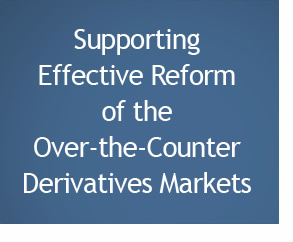
 |
 |
 |
| |
 |
- Successful Clearing of Derivatives is Critical to Lessening Systemic Risk
Central clearing of OTC derivatives is ‘mission critical’ to mitigate the systemic risk associated with the opaque levels of debt and leverage as well as the contagion risks of un-cleared bilateral contracts that contributed to the financial crisis of 2008. Global efforts to limit or eliminate bilateral counterparty risk associated with OTC derivatives will lessen the risk to the global financial system from the hidden leverage of counterparty interconnectedness that characterizes the current OTC market structure.
- Most OTC Derivatives are Eligible for Central Clearing
The vast majority – over 80% – of over-the-counter credit default swaps and interest rate swaps volume is sufficiently standardized and, therefore, suitable for central clearing. Thus, the majority of the OTC derivatives market can benefit from the risk mitigation, liquidity and price valuation transparency of central clearing, thereby serving the interests of market participants, regulators and the investing public.
- Broad Access to Central Clearing
Broad access to central clearing from all trading and qualified clearing firms is essential to realize its systemic benefits and the goals of global regulators. Limited access to central clearing compromises liquidity, distorts prices, concentrates risk and reduces competition and customer choice. Systemic risk is most effectively diffused among a large number of non-correlated market participants employing central clearing in their risk management framework – not among just a handful of global dealer banks. Artificial barriers to clearing house membership intended principally to maintain the status quo must be avoided.
- Make Market Making Requirements for Clearing Firms More Inclusive
Clearing houses should not require OTC derivatives to be cleared only by the firms that, currently, are material traders of the product. This link is designed to protect the lucrative execution business of the large incumbent OTC derivative dealers currently trading this product under a bilateral, ISDA governed framework. Instead, clearing houses should allow clearing brokers to partner with liquidity providers or independent dealers such that they together can deliver the clearing house much needed actionable price data. Ultimately such data will come from Swap Execution Facilities as they go live.
- Objective Membership Standards
Central clearing needs to be available to all qualified trading types across the capital spectrum. Open access is promoted by objective risk based capital and risk based margin standards. This model is the underpinning of the cleared listed derivatives marketplace, such as energy, agriculture and metals futures and options. This allows traders or position takers to introduce to a clearing house an amount of business proportional to their capital encouraging broader participation in clearing and enhanced liquidity and transparency.
- Market Price Transparency
Central clearing of OTC derivatives is directly linked with market price transparency. Opaque pricing information creates possible conflicts of interest and greater chance for inaccuracy and risk with settling derivative markets, especially in a liquidation scenario. Data must be publicly available for market participants, their investors, clearing houses, and regulators as quickly as practical following execution to accurately manage risk.
- Deeper Liquidity Lowers Transaction Costs and Spreads
Central clearing and transparent execution venues will increase liquidity by encouraging more liquidity provider participation in the OTC market. This will lower transaction costs to end-users and enhance the liquidity and portability of existing positions. Liquidity is maximized with participation in clearing and execution by a larger number of market participants whose trading strategies and risk management needs are uncorrelated. Simply stated, trading profits in the marketplace should be made from providing liquidity and not from restricting it.
- Narrow Participant and Product Exemptions
On their face, end-user participant exemptions seem to lower execution costs to end-users. In reality however, today’s bilateral exposure model in the largest OTC derivatives markets preserves information asymmetry and high transaction costs at the expense of customers. Product exemptions, such as volume thresholds or grandfathering, are misguided attempts to derail clearing. Still, clearing exemptions for a narrow set of market participants based on their di minimus volume or for legitimate commercial purposes may be appropriate in some cases. It is important not to permit the socialization of risk, as witnessed during the financial crisis, by overly broad exemption criteria to compromise the larger interests of the majority of market participants and investors.
- Clearing Houses Must Ensure Open and Symmetrical Workflows
Clearing houses must allow agnostic, symmetrical workflow access from Swap Execution Facilities. Indirect trade submission workflows or non anonymous trade submissions that require that one side of a trade must trade through an incumbent dealer are anti competitive at worst and inefficient at best. Such systems are vulnerable, slow and reactive which in times of systemic market upheaval only increase the systemic risk in times of crisis.
- Truly Representative and Transparent Clearinghouse Governance
Effective regulation and transparent governance reduces the potential conflicts of interest that exist when a small group seeks to protect their profits by creating rules and deciding access. If incumbent dealers own a large position and/or have effective control or veto power over a clearing organization then there is greater likelihood that clearing house rules will result in limited access to clearing and a narrower array of clearable instruments. Clearing Houses must be agnostic, and have proportionate market representation on all material committees within their governance structure such that their properly remain independent, agnostic and properly address their key role—that of systemic risk mitigation and mutualization.
|
|
|
|
 |
|
|
 |
| © 2010, The SDMA. All Rights Reserved. |
|
|
|
 |
 |
|
 |
|



